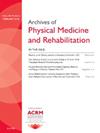Functional and Physiologic Correlates of Opioid Reduction in a Chronic Pain Population with Control Cohort: Cause for Concern? 8250
IF 3.6
2区 医学
Q1 REHABILITATION
Archives of physical medicine and rehabilitation
Pub Date : 2025-04-01
DOI:10.1016/j.apmr.2025.01.058
引用次数: 0
Abstract
Objectives
To investigate the functional and physiological effects of opioid dose reduction in a chronic pain population as compared with those who remained on a stable dose regimen.
Design
Opioid dose reduction was offered to all prescribed opiates for chronic pain therapy, and provided for those agreeing to participation concurrent to those choosing not to do so while rigorously monitoring functional and physiologic outcomes of both groups in a similar fashion. The patients in the interventional group voluntarily had opioid reduction as tolerated of approximately 5% every other month, whereas control patients continued on their same regimen. Outcomes monitored over several years included prescribed average morphine mg dose equivalents (MME), blood pressure, strength, weight, and cognitive function, as well as self-reported Epworth sleepiness, sleep, work, and exercise hours, pain, nausea, constipation, pain disability index, and suicidality levels. Group outcomes were evaluated statistically using multivariate analysis of variance.
Setting
Outpatient specialty clinic.
Participants
Dose-stable chronic pain patients prescribed opiates agreeable to voluntary dose reduction (intervention group, n=103; baseline MME, 174mg/d), versus no dose reduction (control, 118; baseline MME, 144mg/d).
Interventions
Five percent reduction of prescribed medication doses approximately every other month as tolerated.
Main Outcome Measures
Prescribed average MME, self-reported sleep, exercise, and work hours, Epworth Sleepiness scale, nausea, constipation, pain, anxiety (GAD7), depression (Patient Health Questionnaire-9 Scale), and suicidality (SBQ-R) levels, as well as pain disability index ratings, average blood pressures, body mass index, grip strengths, and Trails Making Test performances.
Results
Thirty-seven decreased MME was demonstrated in opioid reduction group (vs no change among controls: P=.002), as well as lesser (P>.05) improvements in Epworth sleepiness and Pain Disability Index scores. However, there was also a significant decrease in overall exercise among the reduction participants (P=.004) not seen among controls, as well as several nonsignificant changes including decreased sleep, increased constipation, nausea, slower cognitive function, and increased suicidality scores among dose reduction participants compared with the others. Pain increased slightly in all.
Conclusions
Opioid dose reduction was significant in this previously stable-dose volunteer cohort, who also demonstrated a significant decrease in exercise participation. There were also nonsignificant trends of less sleep, more constipation and nausea, slower cognitive function and increased suicidality despite improved pain disability index reporting among participants reducing opiate dosage when compared with those maintained on a steady dose regimen suggesting that additional study and careful monitoring are warranted during opioid dose reduction efforts.
Disclosures
none.
求助全文
约1分钟内获得全文
求助全文
来源期刊
CiteScore
6.20
自引率
4.70%
发文量
495
审稿时长
38 days
期刊介绍:
The Archives of Physical Medicine and Rehabilitation publishes original, peer-reviewed research and clinical reports on important trends and developments in physical medicine and rehabilitation and related fields. This international journal brings researchers and clinicians authoritative information on the therapeutic utilization of physical, behavioral and pharmaceutical agents in providing comprehensive care for individuals with chronic illness and disabilities.
Archives began publication in 1920, publishes monthly, and is the official journal of the American Congress of Rehabilitation Medicine. Its papers are cited more often than any other rehabilitation journal.

 求助内容:
求助内容: 应助结果提醒方式:
应助结果提醒方式:


